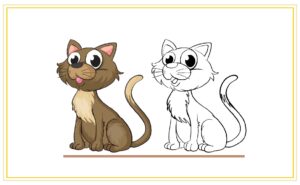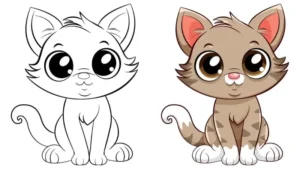In recent years, the world of digital art has expanded rapidly, welcoming innovative techniques and tools that have transformed the way we create and perceive visual media. Among the many subjects that artists enjoy illustrating, cats have always held a special place in the hearts of creatives. Whether depicted in ancient Egyptian murals or modern-day memes, cats have become timeless muses for artists. With the rise of technology, the concept of drawing cats has evolved into the digital realm, giving birth to tools like “iDrawing” and abstract naming conventions like “a4z_-ymtkr8.”
In this article, we’ll explore the influence of digital tools on cat illustrations, the significance of “idrawing” as a digital art tool, and why cats remain a favorite subject for artists in this tech-savvy era.
The Digital Art Boom
Before diving into the specifics of iDrawing and the curious string “a4z_-ymtkr8,” it’s essential to understand the broader context of digital art’s rise. Traditional art forms like painting, sketching, and sculpting have long been dominant, but with the advent of digital technology, artists now have an unprecedented array of options at their disposal. From graphic design software like Adobe Photoshop and Illustrator to specialized programs like Procreate and Krita, the tools available are vast and varied.
What sets digital art apart from traditional methods is its accessibility, flexibility, and ability to evolve rapidly. In the past, artists were limited by physical resources like canvases, paint, and space. Today, artists can create intricate and detailed works of art using just a tablet or computer, allowing for experimentation and growth in ways that were previously impossible.
Enter iDrawing: a versatile, often abstract form of creative expression using various algorithms, brushes, and digital techniques that blend human input with machine-driven output.

iDrawing: A New Way to Create
The term “iDrawing” refers to a style of digital drawing that uses various software tools to create art in an interactive, often algorithmically influenced way. While the name may sound futuristic or technical, at its core, iDrawing is simply a new method of illustrating that leverages the power of digital technology.
Unlike traditional sketching, iDrawing provides the artist with an infinite canvas, layers, and a range of customizable tools such as digital brushes, textures, and effects. Artists can also undo mistakes instantly, allowing for more creative freedom and less fear of error. This non-destructive workflow is one of the significant advantages of digital art, encouraging artists to experiment without the limitations of permanent mediums like ink or paint.
But what about the mysterious combination of letters and numbers, “a4z_-ymtkr8”? It could refer to a file name, a creative code, or perhaps an abstract representation of the endless possibilities within the iDrawing universe. While the exact meaning is open to interpretation, it could also symbolize the flexibility and randomness inherent in digital art creation. Just as every cat illustration may take on unique forms and styles, the file name reflects the infinite potential behind every creative project.
Why Cats?
Cats have always been a popular subject in art, but their presence in digital art and online culture has exploded in recent years. Part of the appeal lies in the diversity of a cat’s physical appearance and behavior. Artists can capture a range of emotions and personalities in a single drawing, from a stoic, majestic feline to a playful, mischievous kitten.
Historically, cats have been associated with various symbolic meanings, from mystery and independence to companionship and elegance. Whether in ancient civilizations or modern pop culture, they have been revered and adored. Today, with platforms like Instagram, TikTok, and Twitter, cats have taken center stage in digital content, whether through animated illustrations, memes, or fan art. The Internet loves cats, and as a result, the world of digital drawing has embraced these creatures wholeheartedly.
For an artist using iDrawing tools, cats provide an ideal subject. Their sleek forms and graceful movements offer endless opportunities to explore different styles and techniques. Digital brushes can capture the soft texture of fur, while layering tools can add depth and shadow to highlight the nuances of a cat’s anatomy. From realistic portrayals to stylized cartoons, the possibilities are endless.
Creating a Digital Cat Illustration: Tools and Techniques
Now that we’ve established the popularity of both iDrawing and cats as subjects, let’s explore how one might approach creating a digital cat illustration using modern digital tools.
- Sketching: Even in digital art, many artists begin with a basic sketch. Using iDrawing’s intuitive sketch tools, an artist might outline the basic shape and proportions of the cat. The digital medium allows for multiple layers, so the initial sketch can remain separate from subsequent stages of the illustration.
- Choosing a Brush: Digital art programs offer a wide range of brushes that simulate traditional media such as pencils, markers, or even airbrushes. For a cat’s fur, many artists choose soft, textured brushes to replicate the varying lengths and textures of the animal’s coat. Programs like Procreate and Photoshop allow artists to adjust brush size, opacity, and flow, which is useful for detailing specific parts of the illustration, like whiskers or shadows.
- Layering: One of the key advantages of digital drawing is the ability to use layers. Layers allow the artist to break down the image into separate parts, such as the background, the cat’s outline, and finer details like the eyes or fur. This non-destructive approach enables experimentation without altering the overall image.
- Coloring: When it comes to coloring a cat illustration, the digital realm offers endless possibilities. Using gradient tools or digital palettes, artists can blend colors seamlessly, achieving effects that are challenging with traditional media. From a tabby’s stripes to a tuxedo cat’s distinctive black-and-white coat, artists can use a combination of shading techniques and color blending to create lifelike textures and details.
- Finishing Touches: After laying down the colors, many artists will go back and add highlights, shadows, and other effects to bring their digital cats to life. iDrawing tools often include filters and effects that allow for the manipulation of light, texture, and even 3D modeling. This adds depth and realism to the illustration, making it pop off the screen.

The Future of Digital Cat Illustrations
As technology continues to evolve, the world of iDrawing and digital illustration will undoubtedly grow more sophisticated. Artificial intelligence (AI) has already started to play a role in digital art, with programs that can analyze and replicate artistic styles. We may soon see AI-assisted tools that help artists create more detailed and realistic cat illustrations faster than ever before.
Augmented reality (AR) and virtual reality (VR) are also emerging as potential platforms for digital art. Imagine being able to “paint” a cat in 3D space, watching it come to life in a fully immersive environment. As these technologies become more accessible, the way we create and consume art will continue to evolve.
Conclusion
The intersection of iDrawing, cats, and digital art represents a fascinating convergence of tradition and innovation. While the term “a4z_-ymtkr8” might remain a mystery, it serves as a reminder that in the world of digital art, creativity knows no bounds. Whether it’s a sleek black panther or a fluffy Persian kitten, the digital tools available today allow artists to push the boundaries of their creativity, making cats the perfect muse for this new era of artistic expression.
